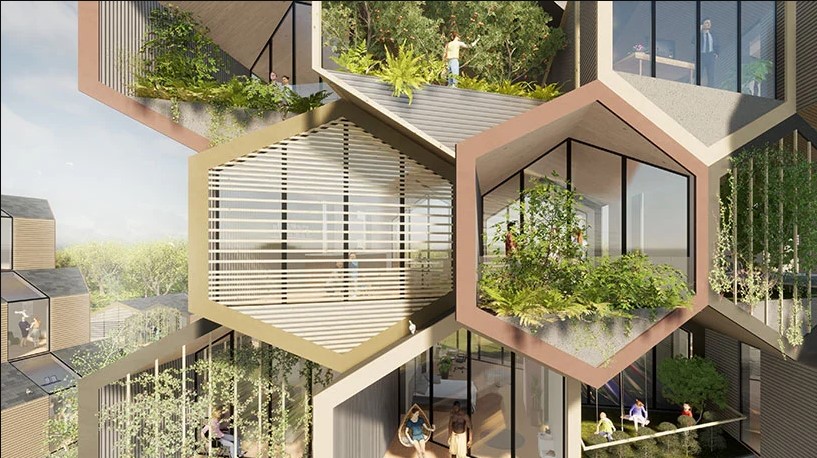Living off the grid may seem like a
near-impossible challenge, but those who dare to try are a great resource for
the rest of us. Not only have self-sufficient homes come a long way in both
their design and feasibility, but they’re introducing us to entirely novel ways
of living.
Builders, designers and architects are
dreaming up more and more creative solutions that incorporate not only
autonomous clean energy generation, but innovative waste, water, and
temperature management. From beehive-like residences to artificial coral reefs,
here are some projects taking autonomous living to a whole new level:

credit: Mathieu Collos
SEA
STEM
Many architects and planners are working hard
on adapting housing to the ever-growing threat of rising sea levels. One such
architect, MathieuCollos, has conceived of not just a house, but an entire
self-sustaining, aquatic habitat called SEA STEM.
- Collos envisioned a building to be
stationed 7.5 miles from Palavas port in France, where the waters are 50 meters
deep. The habitat will rise 30 meters above sea level and include an artificial
reef to help promote marine biodiversity.
- The building will be fully
autonomous, powering itself through wind, solar and turbine energy, producing
its own food through aquaculture and permaculture, and generating its own clean
water by harvesting rainwater and desalination.
- Guests at SEA STEM will be
educated on greener living, as they’ll help maintain the permaculture garden
and learn about marine life through activities involving the artificial reef.
Even sailing and foiling offers will contribute to environmental data
collection via onboard sensors.
- The project is still in its
earliest stages, but aims to find funding through a mixed-use program of
scientific research and eco-tourism.

credit: SYSHAUS
waterlilliHaus
Another great example of using water as
terrain is the Brazilian construction firm SYSHAUS, which has designed a prefabricated
home, the waterlilliHaus, that not only floats on São Paulo
lake, but generates its own energy.
- Specifically designed for use off
of the grid, the waterlilliHaus generates its own electricity through solar
panels installed on its roof. It also collects and treats rainwater for clean
drinking, and filters water waste through a cleansing system before returning
it to nature.
- While the hot Brazilian climate
often calls for air conditioning, the waterlilliHaus utlizes natural
ventilation and the stack effect to keep the building cool. The
building also comes with a smart home system that can be managed from afar and
is compatible with low-energy appliances.
- The small dwelling, measuring 38.4
m2, is mounted on a catamaran that can be sailed or anchored. The homes can be
constructed in under two days thanks to automated machines that also help
minimize waste.

credit: Gianluca
Santosuosso Design
HIVE
One way of creating sustainable, autonomous
homes is to take designs from the natural world into account. Short for
“Human-Inclusive & Vertical Ecosystem,” HIVE
is one such multi-resident, low-carbon housing project, inspired by the
habitats of bees.
- Created by Gianluca Santosuosso Design for the Royal
Institute of British Architects’ design competition “The Home of 2030,” HIVE
buildings are composed of prefabricated wooden honeycomb structures that allow
residents to customize their home as more rooms can be easily added with
biodegradable construction materials, greatly minimizing environmental impact.
- The dwellings are self-sufficient when it comes to energy and water
resources, as they are designed to integrate with renewable energy systems and
come with a water recycling system that safely disposes of wastewater.
- The design of the building itself promotes a Socio-Eco-System: A
circular, local economy where residents share energy and food-generating
systems, minimizing unnecessary waste and fostering social cohesion.

credit: Vox Creative
IKEA
Tiny Home
The famous Swedish home retailer has partnered
with Vox Creative to go beyond furniture and hardware and take home improvement
to the next level by upgrading the home itself. The result is the Tiny Home Project, a mobile micro-dwelling
that isn’t reliant on any grid.
- The 17.4-square-meter abode
includes solar panels, a composting toilet, and an optional water heater. The
structure rests on wheels and can be easily attached to a vehicle.
- The interior of the tiny home is
equipped with solar panels, lined with sustainable wood and furnished with
IKEA’s sustainable and energy-efficient products, such as kitchen fronts made
from recycled bottles and a water-saving thermostatic shower head.
- The project was completed in 2020,
but it’s U.S. release was put on hold due to the pandemic. One model of the
tiny home is currently available for order, starting at $47,550.
